Arm Announces Neoverse N1 & E1 Platforms & CPUs: Enabling A Huge Jump In Infrastructure Performance
by Andrei Frumusanu on February 20, 2019 9:00 AM ESTFirst N1 Silicon: Enabling the Ecosystem with SDPs
A little known fact about Arm is that the company designs its own silicon test platform – actually deploying them on development board to enable validation and software development on hardware that Arm and developers have full control of. The latest generation was the Juno platform, which in its first revision started off with a Cortex A57 and served as the fundamental silicon testbed for ARMv8 software.
Ever since Arm started the programme in 2014, Arm has shipped over 1400 boards both internally and to its partners. The amount of chips we’re talking about here sounds paltry, however we have to keep in mind we’re talking about very limited shuttle runs on MPW (multi-project wafers) where Arm shares wafer space with numerous other companies.
For today’s announcement, Arm had the pleasure to reveal that it received back the first working Neoverse N1 silicon back in December – with the chips meant to be integrated into the new Neoverse System Development Platform (SDP).
The N1 SDP represents major step for Arm as it not only is the first silicon to come back with the N1 CPU, but also is Arm’s first own 7nm silicon. The platform represents a major proof of concept of the IP, as well as interoperability with third-party IP, employing a lot of the peripheral IP such as PCIe and DDR PHY supplied by Cadence.
The actual hardware is a limited implementation of an N1 SoC – we find a 4-core N1 CPU with 1MB L2 configuration in the form of 2xMP2 connected to a CMN-600 with an 8MB SLC setup.
The board includes a CCIX compatible PCIe 4.0 x16 slot which serves the crucial role of enabling development and demonstrating cache-coherent integration with CCIX hardware such as Xilinx’s FPGA.
The N1 SoC actually doesn’t contain dedicated I/O IP, rather Arm implements all connectivity via a dedicated FPGA which serves as the I/O hub, supporting various connectivity options such as Ethernet, USB, SATA and so on.
Naturally the big selling point of the SDP is its completely open-source firmware stack from not only the OS drivers, but more importantly the SCP and MCP firmware.
An important new feature that is first employed by the new N1 CPU is the introduction of statistical profiling extensions (SPE). The new extension enables the first ever self-hosted profiling capability in an Arm CPU – meaning we don’t require a separate CPU or system having to read out microarchitectural counters. Instead the new SPE can be configured to directly write this information into memory. The tool is extremely useful for tracing code and analysing core behaviour, identifying possible performance issues and further squeezing out the maximum performance out of a platform, something Arm is taking very seriously if it wants to succeed and gain adoption in HPC.
Finally, the N1 SDP will be available later this quarter – although don’t expect the board to be easily attainable for the average user.


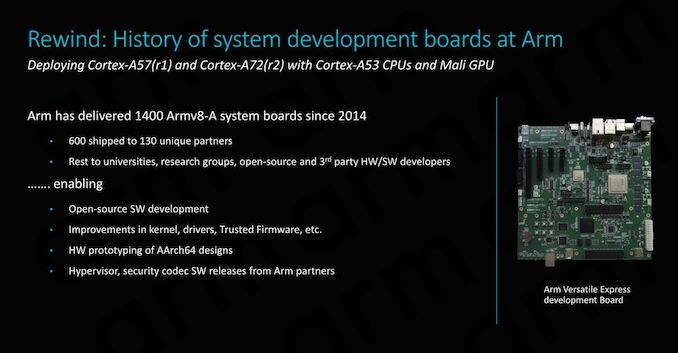
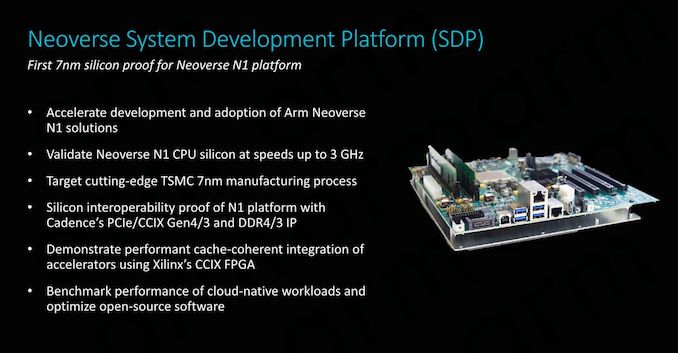
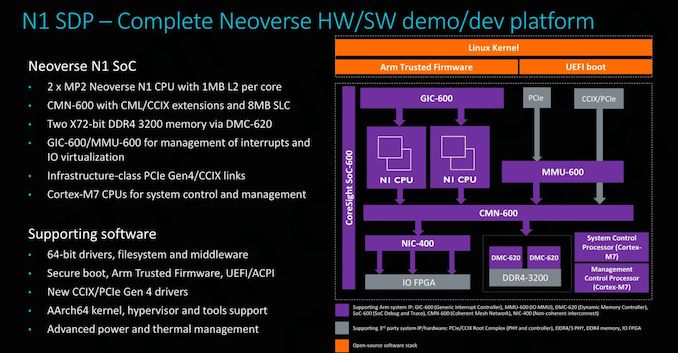
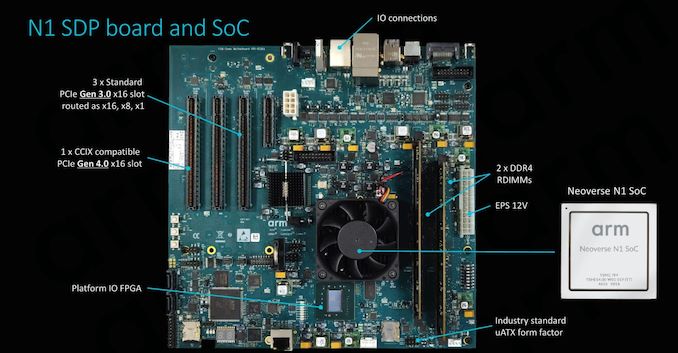

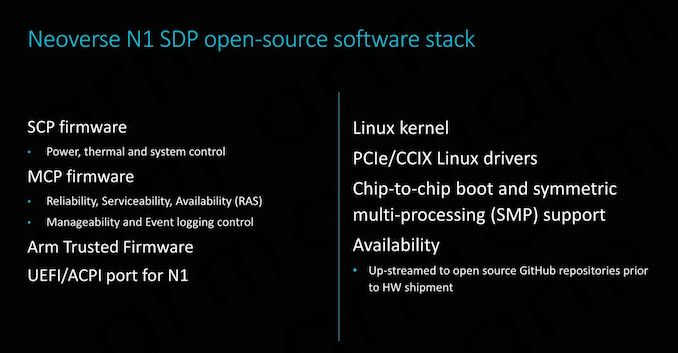

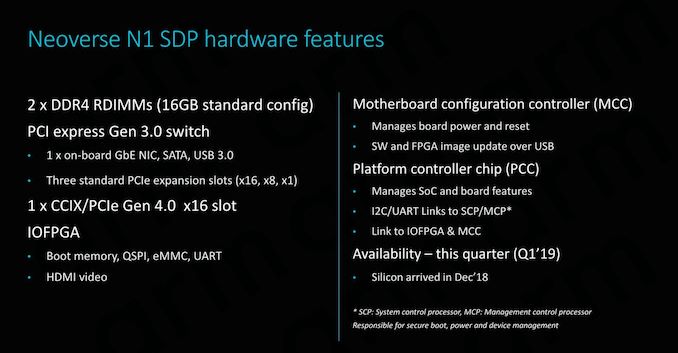








101 Comments
View All Comments
Antony Newman - Thursday, February 21, 2019 - link
(Arbitrary example)If a SoC can run at 5GHz when 8 cores single core, but throttles down to 2.5GHz when 16 cores are active - then it cannot scale (due to the TDP limit).
If ARM are designing their CPUs so that 128 (ie all) of them can run flat out without requiring throttling, then ARMs single core performance is indicative of the overall performance.
If ARM increase their single core performance by 1.7 times in two years - and keep this same MO (of no Throttling cause to keep within the TDP) - it will be more than just data centres that want to buy into this new architecture.
AJ
wumpus - Thursday, February 21, 2019 - link
Very few problems scale without penalty. Having high single core performance (for each core in a multichip server CPU, obviously. The Intel result using all of its cache on one core is obviously irrelevant and why it was so anomalous vs. AMD) means far less cores are needed, when scaling up. Also adding more and more cores require as much cache or more. If not, your bandwidth will scale even worse.Single core is absolutely critical for servers, and why it is taking ARM so long to break in. IBM is the exception that proves the rule: but they rely on weird licensing rules and making sure all the threads can access the same cache.
eastcoast_pete - Thursday, February 21, 2019 - link
I actually think we are in agreement. While this borders on semantics, per core performance is, of course, very important for servers, while high single (one) core is not. As you point out, Intel getting really high one core performance from a 18 core Xeon by running a strictly single core/thread test while allocating all the cache and much of the thermal envelope to that one core is an artificial situation for a server.The_Assimilator - Wednesday, February 20, 2019 - link
Remember when "system on chip" meant IO too? Apparently Arm doesn't.Remember when Arm chips didn't need HSFs to run? Pepperidge Farm remembers.
I'm going to enjoy it when this, like all of Arm's previous attempts at the high-end, fails once again. Or when Lakefield eats Arm's lunch, whichever comes first.
wumpus - Wednesday, February 20, 2019 - link
When your volume is 1400 chips (not all the same design) over 4 years, you use FPGA for anything you can. Doing anything else is pretty dumb. I'm surprised they bothered with an actual layout, but I suspect that they've been bitten by tiny details in FPGA simulation that never quite worked the same at speed.HSF? You want the MIPS, you burn the Watts. Presumably this is your "tell" in your troll.
When has ARM made a previous attempt at the high-end? Certainly more than a few of their architectural licensees have, but there's a huge difference between a server architecture backed by ARM and even one backed by Qualcom. For one thing, they pretty much need to standardize remote adminstration to Intel levels (possibly circa ~2008ish to get off the ground). That's a lot of pesky little details, but something they absolutely need standardized to allow server use in the datacenter (yes, the Big Boys can roll their own, but everybody else needs a common server definition.
Antony Newman - Wednesday, February 20, 2019 - link
Fascinating article.Do you think Ampere, Huawei, Cavium and Amazon will all switch to the Neoverse?
In terms of IPC - do you have a view on if ARM have Caught up with Apples Vortex yet?
Is there any reason why a mobile phone (or Tablet) maker would’t use the ARM ‘server’ chip in a fondleslab?
AJ
ballsystemlord - Wednesday, February 20, 2019 - link
Spelling and grammar corrections:...the actual real-life performance improvements will higher due other SoC-level improvements as well as software improvements that aren't available in existing actual A72 silicon products.
Missing be:
...the actual real-life performance improvements will behigher due other SoC-level improvements as well as software improvements that aren't available in existing actual A72 silicon products.
The figured weren't run actual silicon but rather estimated on Arm's server farm in an emulation environment with RTL.
Miswritten sentence:
The figures weren't calculated on actual silicon but rather estimated on Arm's server farm in an emulation environment with RTL.
The E1's CPU pipeline actually represents a brand new-design which (besides the A65) haven't seen employed before.
Missing we:
The E1's CPU pipeline actually represents a brand new-design which (besides the A65) we haven't seen employed before.
Here we have to clusters of 8 cores in a small CMN-600 2x4 mesh network, ...
Wrong 2:
Here we have two clusters of 8 cores in a small CMN-600 2x4 mesh network, ...
I was half asleep when I read it so there might be more.
sohntech43 - Wednesday, February 20, 2019 - link
Could someone help me understand why the Spec CPU2006 results are so different from those recorded for the AMD 7601 (1000 - 1200 vs. 690.63) and Xeon Platinum results (1300+ vs 730) in the Spec data base?https://www.spec.org/cpu2006/results/cpu2006.html
They are also different from what AMD was boasting at the time of the original EPYC launch:
https://www.microway.com/download/whitepaper/AMD-E...
I'm probably missing something obvious...
Wilco1 - Wednesday, February 20, 2019 - link
Yes you're missing the fact these are GCC8 scores using -Ofast as mentioned in the article - ie. like when you build code yourself.Official SPEC scores are quite different and use special trick compilers to get the highest score. For example libquantum shows a completely unrealistic result in most SPEC submissions which artificially inflates the integer score by 30+%.
sohntech43 - Wednesday, February 20, 2019 - link
Thanks - was surprised by the sheer magnitude of the delta caused by the compilers. Impressive results for N1 and will be interesting to see when silicon is available.